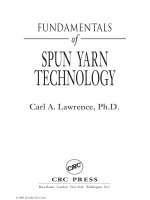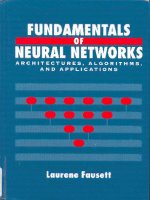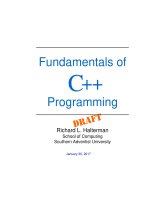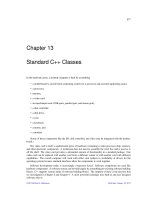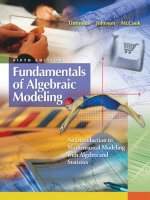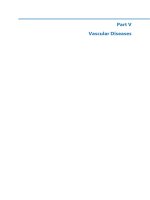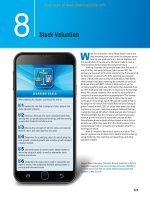Ebook Fundamentals of multimedia: Part 2
Bạn đang xem bản rút gọn của tài liệu. Xem và tải ngay bản đầy đủ của tài liệu tại đây (25.24 MB, 316 trang )
CHAPTER
9
Image Compression Standards
Recent years have seen an explosion in the availability of digital images, because of the
increase in numbers of digital imaging devices, such as scanners and digital cameras. The
need to efficiently process and store images in digital form has motivated the development
of many image compression standards for various applications and needs. In general,
standards have greater longevity than particular programs or devices and therefore warrant
careful study. In this chapter, we examine some current standards and demonstrate how
topics presented in Chapters 7 and 8 are applied in practice.
We first explore the standard JPEG definition, used in most images on the web, then
go on to look at the wavelet-based JPEG2000 standard. Two other standards, IPEG-LS aimed particularly at a lossless IPEG, outside the main IPEG standard - and illIG, for
bilevel image compression, are included for completeness.
9.1
THE JPEG STANDARD
IPEG is an image compression standard developed by the Joint Photographic Experts Group.
It was formally accepted as an international standard in 1992 [1].
IPEG consists of a number of steps, each of which contributes to compression. We'll
look at the motivation behind these steps, then take apart the algorithm piece by piece.
9.1.1
Main Steps in JPEG Image Compression
As we know, unlike one-dimensional audio signals, a digital image lei, j) is not defined
over the time domain. Instead, it is defined over a spatial domain - that is, an image is a
function of the two dimensions i and j (or, conventionally, x and y). The 2D DCT is used
as one step in JPEG, to yield a frequency response that is a function F(u, v) in the spatial
frequency domain, indexed by two integers II and v.
JPEG is a lossy image compression method. The effectiveness of the Dey transform
coding method in JPEG relies on three major observations:
Observation 1. Useful image contents change relatively slowly across the imagethat is, it is unusual for intensity values to vary widely several times in a small area for example, in an 8 x 8 image block. Spatial frequency indicates how many times
pixel values change across an image block. The DCT formalizes this notion with a
measure of how much the image contents change in relation to the number of cycles
of a cosine wave per block.
Observation 2. Psychophysical experiments suggest that humans are much less likely
to notice the loss of very high-spatial-frequency components than lower-frequency
components.
253
254
Chapter 9
Image Compression Standards
YIQor YUV
fCi,j)
Felt, v)
DCT
D
Feu, v)
Quantization
0
0
t
8x8
.
:------------------~
I
I
I
1- _
I
I
I
I
Header
Tables
,,
I
~
~
-- Quantization
tables
Coding
tables
{
__l
r DPCM
Entropy
Data
DC
1
J
coding
Zigzag
-
1
RLC
J
AC
FIGURE 9.1: Block diagram for JPEG encoder.
JPEG's llPproach to the use of DCT is basically to reduce high-~requency_contents al!d
then ~ffi9~ntlycode the-result iniOabltstri~i.~-Th~-teim-iP-;;ii~7 ;-ed;~ida;;cy i~dicatesthat
much oithf;jtlt~[~~tioni~ ?~-iIJlllg~isrepeated: jf a pixel is red~ then its-;:eigh~or is likely
red-also. Because of Observation 2 above, the Dcicoefficients for the l()wlOst frequ~ncies
are most Important. Therefore, as -frequency gets higher, it~becomes- J_es_sjmportant~o
represent the DCT coefficient accurately. It may even be safely set to zer.o without losing
much perceivable image i n f o r m a t i o n . - - ---Clearly, a string of zeros can be represented efficiently as the length of such a run of
zeros, and compression of bits required is possible. Since we end up using fe\ver numbers
~o represent the pixels in blocks, by removing som~locati6n~aeJ2ei1clentinf~lID_a,tion,__we
have effectively removed spatial redundancy.
JPEG works for both color and grayscale images. In the case ofcolor images, such as YIQ
or YUV, the encoder works on each component separately, using the same routines. If the
source image is in a different color format, the encoder performs a color-space conversion
to YIQ or YUV. As discussed in Chapter 5, the chrominance images (l, Q or U, V) are
subsampled: r IPEG
usesJ!1e 4:~:9
--r------' - scheme, making use of another observation about vision:
.~
< - __
,
--
-
-._
-
0
._~_
-_
Observation 3. Yi~ll.1l1 acuity Jaccuracy in distinguishing closely _spaced_lines) is
much greater for gray ("black and white;') than for color. We simply canngt see much
llnge in color if it occurs in close proximity- think of the blobby ink ;s~d in comic
"6QQlcs. This works simply because our eye sees the black lines best, and our- brain
just pushes the color into place. In fact, ordinary broadcast TV makes use of this
phenomenon to transmit much less color information than gray information.
ch
Section 9.1
The JPEG Standard
255
When the JPEG image is needed for viewing, the three compressed component images
can be decoded independently and eventually combined. For the color channels, each pixel
must be first enlarged to cover a 2 x 2 block. Without loss of generality, we will simply use
one of them - for example, the Y image, in the description of the compression algorithm
below.
Figure 9.1 shows a block diagram for a JPEG encoder. If we reverse the aITOWs in the
figure, we basically obtain a JPEG decoder. The JPEG encoder consists of the following
main steps:
• Transform RGB to YIQ or YUV and subsample color
e
Perform DCT on image blocks
• Apply Quantization
e
Perform Zigzag ordering and run-length encoding
• PerfOlID Entropy coding
DCT on Image Blocks. .Each image is ~ividedjnto8x_8 bIQcl<:s.]'4e_2Q !?CT(pquation 8.17)js applied to e~c:h_bI6ckTmage-i(i, i), wHh output beiDtlh~I!CTc()efficiellts
F(ll,v)for ea.~bj9ck~ The choice ([a small block size in JPEG is a compromise reached
by the committee: a number larger than 8 would have made accuracy at low frequencies
better, put using 8 make~JI.l~DIT-iamtlR~T) c01l!2utation ver;,-fast.
Using blocks at all, however, has the effect of isolating each block from its neighboring
context. This is why JPEG images look choppy ("blocky") when the user specifies a high
compression ratio - we can see these blocks. (And in fact removing such "blocking
artifacts" is an important concern of researchers.)
To calculate a particular F(u, v), we select the basis image in Figure 8.9 that corresponds
to the appropriate II and v and use it in Equation 8. 17 to derive one of the frequency responses
F(u, v).
Quantization.
The quantization step in JPEG is aimed at reducing the total nL!.W.ber
of bils _nee_cle~J2~~i.Q1D.pt.:ess~d)m~g~I:2j.-ftConsistsof simply dividing;~ch entry in the
frequency space block by an integer, then rounding:
.
.
h
F(u, v) = round
(F(U,V»)
Q(u, v)
(9.1)
Here, F(u, v) represents a DCT coefficient,Q(u.tJ!»s_a qliallf~gtion matrixen.try,
coding.
--- --- . -Th~ default values in the 8 x 8 quantization matrix Q(u, v) are listed in Tables 9.1
and 9.2 for luminance and chrominance images, respectively. These numbers resulted from
psychophysical studies, with the goal ofmaximizing the compression ralio while minimizing
perceptual losses in JPEG images. The following should be apparent:
256
Chapter 9
Image Compression Standards
TABLE 9.1: The luminance quantization table.
16
12
14
14
18
24
49
72
11
12
10
22
35
14
16
22
37
55
64
78
92
95
13
17
16
19
24
29
56
64
87
98
24
26
40
51
68
81
103
112
40
58
57
87
109
104
121
51
60
69
80
103
113
100
103
120
61
55
56
62
77
92
101
99
TABLE 9.2: The chrominance quantization table.
17
18
24
47
99
99
99
99
18
21
26
66
99
99
99
99
24
26
56
99
99
99
99
99
47
66
99
99
99
99
99
99
99
99
99
99
99
99
99
99
99
99
99
99
99
99
99
99
99
99
99
99
99
99
99
99
99
99
99
99
99
99
99
99
• Since the numbe.r~U1LQ(u, v) are relatively large, the magnitude and,,~riance of
'71(/;, v) are-slgnifi~antly_sm~!ler than those ofF(u, v). We'll seelater that Feu, v)
can oe codea \vith many fewer bits. The quantization step is the mgin,sQurcefor loss
in IPEG compression.
.
-"
• The entries of Q(u, v) tend to have larger values toward the lower right comer. This
tjims -to "inTroduce more loss at the higher spatial frequencies- a practice supported
by Observ<:ttionsland 2.
We can handily, change the compression ratio simply by multiplicatively scaling the
numbers in the Q(u, v) matrix. In fact, the quality factor, a user choice offered in every
JPEG implementation, is essentially linearly tied to the scaling factor. JPEG also allows
custom quantization tables to be specified and put in the header; it is interesting to use lowconstant or high-constant values such as Q "" 2 or Q "" 100 to observe the basic effects of
Q on visual artifacts.
Figures 9.2 and 9.3 show some results of JPEG image coding and decoding on the test
image Lena. Only the luminance image (Y) is shown. Also, the lossless coding steps
Section 9.1
257
The JPEG Standard
An 8 X 8 block from the Y image of 'Lena'
200
200
203
200
200
200
205
210
202
203
200
200
205
200
200
200
189
198
200
200
200
200
199
200
188
188
195
200
200
200
200
200
189
189
200
197
195
200
191
188
175
182
187
187
188
190
187
185
175
178
185
187
187
187
187
187
175
175
175
187
175
175
175
186
515 65
-16 3
-12 6
-8 3
o -2
a -3
3 -2
-2 5
-12
2
11
-4
7
-1
-3
-2
6 -1
a
0
-1
-I
0
1
0
0
0
0
0
0
0
0
0
0
0
0
0
0
0
0
0
0
0
0
0
0
0
0
0
0
0
0
0
0
0
0
0
0
0
0
0
0
0
0
0
0
0
0
0
a
0
0
0
0
0
0
512 66 -10
-12 0 0
-14 0 16
-14 a 0
196
199
203
203
201
200
202
204
191
196
202
204
202
199
199
200
186
192
200
203
201
197
195
194
182
188
195
198
196
192
190
190
lu,})
FIGURE 9.2:
L
-1 3
2 -2
-5 4
0 4
3 3
4 -2
0
0
0
0
2 -8
-2
0 1
-3 -5
0 -1
1 -1
-1 -1
2 -3
a
0
0
0
0
0
0
0
0
0
0
0
0
0
0
0
0
0
0
0
0
0
0
0
0
0
0
Felt, v)
199
201
203
202
200
200
204
207
1
0~11
5
3
-2
-2
-4
a
-3
0
F(u, v)
f(i,})
32
-1
4
a
a
0
0
0
0
0
0
0
0
0
0
a
a
0
0
0
0
0
0
0
0
0
0
F(ll, v)
178
183
189
191
189
186
186
187
177
180
183
183
182
181
183
185
176
178
180
179
177
177
181
184
1
-1
6 -2 2 7 -3 -2 -1
4 2 -4 1 -1 -2 -3
0 -3 -2 -5 5 -2 2 -5
-2 ~3 -4 -3 -1 -4 4 8
0 4 -2 -1 -1 -1 5 -2
0 0 1 3 8 4 6 -2
1 ~2 0 5 1 1 4 -6
3 -4 0 6 -2 -2 2 2
EU,}) =f(i,))
-lu,))
JPEG compression for a smooth image block.
258
Chapter 9
Image Compression Standards
Another 8 x 8 block from the Y image of 'Lena'
70
85
100
136
161
161
146
156
70
100
85
69
70
123
147
146
100
96
116
87
87
147
175
189
70
79
79
200
200
133
100
70
87
87
70
79
103
113
103
113
87
154
87
71
71
113
103
161
150
87
86
117
96
85
163
163
187
113
196
96
113
161
187
197
-80
-135
47
-2
-1
5
6
-5
fCi,})
-5 -4 9 -5
-11 -5 -2 0
3 -6 4 0
0 1 -1 0
0 0 -1 0
o -1 1 -1
0 0 0 0
0 0 0 0
60
101
99
53
57
123
159
141
106
85
92
111
114
131
169
195
94
75
102
180
207'
135
73
79
2 1
1 0
-3 -1
1 0
0
1
0 0
0 0
0 0
62
102
74
55
III
133
106
101
l(i,})
-3
-28
59
1
-1
24
17
20
F(u, v)
1 0
0 -1
0 1
0 0
0 0
0 0
0 0
0 0
hu, v)
70
85
98
132
173
164
141
150
-40 89 -73
44 32 53
-59 -26 6
14 -3 -13
-76 66 -3 -108 -78 33
10 -18 0
33 11-21
-9 -22 8
32 65 -36
-20 28 -46
3 24-30
12 -35 33
-20 37 -28
-23 33 -30
17 -5 -4
-80
-132
42
0
0
0
0
0
-44 90 -80
48 40 51
0
-60 -28 0
26
0 o -55
-78 64 o -120 -57 0 56
17 -22 0
0
0 0
51
o -37 0
o 109 0 0
0
-35 55 -64
0 0
0
0
0 0
0
0
0 0
0
0 0
0
0
0 0
F(lI, v)
103
127
98
70
89
92
101
147
146
93
89
106
84
85
149
210
176
144
167
145
90
162
224
153
25 -16 4
0 10 -6 -24
0 -1 11 4 -15 27 -6
-4 -11 -3
2 -14 24 -23
24
1 11
4 16 -24 20
-12 13 -27 -7 -8 -18 12
-3
0 16 -2 -20 21 0
6 27 -3 -2 14
5 -12
-6
-9
5
6
6 14-47
EU,}) = fU,j) -lei,})
FIGURE 9.3: JPEG compression for a textured image block.
11
-31
29
-49
23
-1
-37
44
Section 9.1
The JPEG Standard
259
after quantization are not shown, since they do not affect the qualitylloss of the JPEG
images. These results show the effect of compression and decompression applied to a
relatively smooth block in the image arid a more textured (higher-frequency-content) block,
respectively.
Suppose IU, j) represents one of the 8 x 8 blocks extracted from the image, F(u, v)
the DCT coefficients, and F(u, v) the quantized DCT coefficients. Let F(u, v) denote
the de-quantized DCT coefficients, detennined by simply multiplying by Q(u, v), and let
I (i, j) be the reconstructed image block. To illustrate the quality of the JPEG compression,
especially the loss, the errOrE (i, j) = l(i, j) - l(i, j) is shown in the last row in Figures 9.2
and 9.3.
In Figure 9.2, an image block (indicated by a black box in the image) is chosen at the
area where the luminance values change smoothly. Actually, the left side of the block is
brighter, and the right side is slightly darker. As expected, except for the DC and the first
few AC components, representing low spatial frequencies, most of the DCT coefficients
F(u, v) have small magnitudes. This is because the pixel values in this block contain few
high-spatial-frequency changes.
An explanation of a small implementation detail is in order. The range of 8-bit luminance
values I (i, j) is [0, 255]. In the JPEG implementation, each Y value is first reduced by 128
by simply subtracting.
The idea here is to tum the Y component into a zero-mean image, the same as the
chrominance images. As a result, we do not waste any bits coding the mean value. (Think
of an 8 x 8 block with intensity values ranging from 120 to 135.) Using l(i, j) - 128 in
place of l(i, j) will not affect the output of the AC coefficients ~ it alters only the DC
coefficient
In Figure 9.3, the image block chosen has rapidly changing luminance. Hence, many
more AC components have large magnitudes (including those toward the lower right comer,
where u and v are large). Notice that the error E (i, j) is also larger now than in Figure 9.2
~ JPEG does introduce more loss if the image has quickly changing details.
Preparation for Entropy Coding.
We have so far seen two of the main steps in
JPEG compression: DCT and quantization. The remaining small steps shown in the block
diagram in Figure 9.1 all lead up to entropy coding of the quantized DCT coefficients. These
additional data compression steps are lossless. Interestingly, the DC and AC coefficients are
treated quite differently before entropy coding: run-length encoding on ACs versus DPCM
on DCs.
Run.Length Coding (RLC) on AC Coefficients. Notice in Figure 9.2 the many zeros
in F(ll, v) after quantization is applied. Run-length Coding (RLC) (or Run-length Encoding,
RLE) is therefore useful in turning the FCII, v) values into sets {#-zeros-to-skip, next nonzero value}. RLC is even more effective when we use an addressing scheme, making it
most likely to hit a long run of zeros: a zigzag scan turns the 8 x 8 matlix F(u, v) into a
64-vectol', as Figure 9.4 illustrates. After all, most image blocks tend to have small highspatial-frequency components, which are zeroed out by quantization. Hence the zigzag
260
Chapter 9
Image Compression Standards
FIGURE 9.4: Zigzag scan in JPEG.
scan order has a good chance of concatenating long runs of zeros. For example,
Figure 9.2 will be turned into
ft (II, v) in
(32,6, -1, -1,0, -1,0,0,0, -1,0,0,1,0,0, ... ,0)
with three runs of zeros in the middle and a run of 51 zeros at the end.
The RLC step replaces values by a pair (RUNLENGTH, VALUE) for each run of zeros
in the AC coefficients of ft, where RUNLENGTH is the number of zeros in the run and
VALUE is the next nonzero coefficient. To further save bits, a special pair (0,0) indicates
the end-of-block after the last nonzero AC coefficient is reached. In the above example, not
considering the first (DC) component, we will thus have
(0,6)(0, -1)(0,
~1)(I,
-1)(3, -1)(2,1)(0,0)
Differential Pulse Code Modulation (DPCM) on DC Coefficients. The DC coefficients are coded separately from the AC ones. ~ach 8~_8irnage blo~~bas.ow.y one
DC coefficient. .The values of the DC coefficients for various blocks could be large and
dIfferent; because the DC~alue reflects the '~v~rage intensity of each block, but consIstent
\vithOoservatkm 1 above, the DC coefficient is unlikely to change drastically'\yithin a short
'distance: This makes DPCM an ideal scheme for coding the DC coefficients.
.
If the DC coefficients for the first five image blocks are)50, 155, 149, 152, 144, D.fCM
would produce 150, 5,· -6, 3, ~8, assuming the pr~dictor for the ith block-is'-simply
d i = DCi+l - DCi> and do = DCa. We expect DPCNI codes to generally have smaller
magnitude and variance, which is beneficial for the next entropy coding step.
It is worth noting that unlike the nm-length coding of the AC coefficients, which is
performed on each individual block, DPCM for the DC coefficients in JPEG is carried out
on the entire image at once.
_.-~._._~--~.-
-1-
--
Section 9.1
The lPEG Standard
261
TABLE 9.3: Baseline entropy coding details ~ size category.
SIZE
AMPLITUDE
1
-1,1
2
3, -2, 2, 3
3
~7
.. -4, 4 .. 7
4
-15 .. -8, 8 .. 15
10
-1023 .. -512, 512 .. 1023
Entropy Coding The DC and AC coefficients tinally undergo an entropy coding step.
Below, we will discuss only the basic (or baseline l ) entropy coding method, which uses
Huffman coding and supports only 8-bit pixels in the original images (or color image components).
/
Let's examine the two entropy coding schemes, using a variant of Huffman coding for
DCs and a slightly different scheme for ACs.
Huffman Coding of DC Coefficients Each DPCM-coded DC coefficient is represented
by a pair of symbols (SIZE, A11PLITUDE), where SIZE indicates how many bits are
needed for representing the coefficient and AHPLITUDE contains the actual bits.
Table 9.3 illustrates the size category for the different possible amplitudes. Notice that·
DPCM values could require more than 8 bits and could be negative values. The one'scomplement scheme is used for negative numbers ~ that is, binary code 10 for 2, 01 for
-2; 11 for 3, 00 for -3; and so on. In the example we are using, codes 150, 5, -6,3, ~8
will be turned into
(8, 10010110), (3, 101), (3,001), (2, 11), (4,0111)
In the JPEG implementation, SIZE is Huffman coded and is hence a variable-length
code. In other words, SIZE 2 might be represented as a single bit (0 or 1) if it appeared
most frequently. In general, smaller SIZEs occur much more often ~ the entropy of
SIZE is low. Hence, deployment of Huffman coding brings additional compression. After
encoding, a custom Huffman table can be stored in the JPEG image header; otherwise, a
default Huffman table is used.
On the other hand, AHPLITUDE is not Huffman coded. Since its value can change
widely, Huffman coding has no appreciable benetit.
IThe JPEG standard allows both Huffman coding and Arithmetic coding; both are entropy coding methods. It
also supports both S-bit and 12-bit pixel lengths.
262
Chapter 9
Image Compression Standards
Huffman Coding of AC Coefficients. Recall we said that the AC coefficients are runlength coded and are represented by pairs of numbers (RUNLENGTH I VALUE). However,
in an actualJPEG implementation, VALUE is furtherrepresented by SIZE and AMPLITUDE,
as for the DCs. To save bits, RUNLENGTH and SIZE are allocated only 4 bits each and
squeezed into a single byte ~ let's call this Symboll. Symbol 2 is the AMPLITUDE value;
its number of bits is indicated by SIZE:
Symbol!: (RUNLENGTH, SIZE)
Symbol 2: (Al1PLITUDE)
The 4-bit RUNLENGTH can represent only zero-runs of length 0 to 15. Occasionally, the
zero-run length exceeds 15; then a special extension code, (15,0), is used for Symbol 1. In
the worst case, three consecutive (15, 0) extensions are needed before a normal terminating
Symbol!, whose RUNLENGTH will then complete the actual runlength. AsinDC, Symbol!
is Huffman coded, whereas Symbol 2 is not.
9.1.2
JPEG Modes
The JPEG standard supports numerous modes (variations). Some of the commonly used
ones are:
• Sequential Mode
• Progressive Mode
• Hierarchical Mode
• Lossless Mode
Sequential Mode. This is the default JPEG mode. Each gray-level image or color
image component is encoded in a single left-to-right, top-to-bottom scan. We implicitly
assumed this mode in the discussions so far. The "Motion JPEG" video codec uses Baseline
Sequential JPEG, applied to each image frame in the video.
Progressive Mode. Progressive JPEG delivers low-quality versions ofthe image quickly,
followed by higher-quality passes, and has become widely supported in web browsers. Such
multiple scans of images are of course most useful when the speed of the communication
line is low. In Progressive Mode, the first few scans carry only a few bits and deliver a rough
picture of what is to follow. After each additional scan, more data is received, and image
quality is gradually enhanced. The advantage is that the user-end has a choice whether to
continue receiving image data after the first scan(s).
Progressive JPEG can be realized in one of the following two ways. The main steps
(DCT, quantization, etc.) are identical to those in Sequential Mode.
Spectral selection: This scheme takes advantage of the spectral (spatial frequency spectrum) characteristics of the DCT coefficients: the higher AC components provide
only detail information.
Section 9.1
The JPEG Standard
263
Scan 1: Encode DC and first few AC components, e.g., ACl, AC2.
Scan 2: Encode a few more AC components, e.g., AC3, AC4, AC5.
Scan k: Encode the last few ACs, e.g., AC61, AC62, AC63.
Successive approximation: Instead of gradually encoding spectral bands, all DCT coefficients are encoded simultaneously, but with their most significant bits (MSBs) first.
Scan 1: Encode the first few MSBs, e.g., Bits 7, 6, 5, and 4.
Scan 2: Encode a few more less-significant bits, e.g., Bit 3.
Scan m: Encode the least significant bit (LSB), Bit O.
Hierarchical Mode. As its name suggests, Hierarchical JPEG encodes the image in
a hierarchy of several different resolutions. The encoded image at the lowest resolution is
basically a compressed low-pass-filtered image, whereas the images at successively higher
resolutions provide additional details (differences from the lower-resolution images). Similar to Progressive JPEG, Hierarchical JPEG images can be transmitted in multiple passes
with progressively improving quality.
Figure 9.5 illustrates a three-level hierarchical JPEG encoder and decoder (separated by
the dashed line in the figure).
F4
J4
Decode
I
I
1
I
1
I
,r
+~72
j
I
I
I
I
I
I
I
I
I
I
I
I
I
I
I
I
.d1 ""j-E(j2)
I
D 1:
d2
7
2 ;;,;
Decode
E(]4) +d2
Decode
d1
T
FIGURE 9.5: Block diagram for Hierarchical JPEG.
+
7;;,;
E(]2) +d1
264
Chapter 9
Image Compression Standards
ALGORITHM 9.1
THREE-LEVEL HIERARCHICAL JPEG ENCODER
1. Reduction of image resolution. Reduce resolution of the input image 1 (e.g., 512 x
512) by a factor of 2 in each dimension to obtain 12 (e.g., 256 x 256). Repeat this to
obtain 14 (e.g., 128 x 128).
2. Compress low-resolution image 14' Encode 14 using any other JPEG method (e.g.,
Sequential, Progressive) to obtain F4.
3. Compress difference image d 2 •
(a) Decode F4 to obtain ]4. Use any interpolation method to expand ]4 to be of the
same resolution as 12 and call it E(j4).
(b) Encode difference dz = 12 - E (J4) using any otherJPEG method (e.g., Sequential,
Progressive) to generate Dz.
4. Compress difference image d l •
(a) Decode Dz to obtaind;; add it to E(]4) to get]2 = E(]4) +dz, which is a version
of 12 after compression and decompression.
eb)Encode difference d1 = 1- EeJz) using any other JPEG method (e.g., Sequential,
Progressive) to generate D1.
ALGORITHM 9.2
THREE-LEVEL HIERARCHICAL JPEG DECODER
1. Decompress the encoded low-resolution image F4. Decode F4 using the same JPEG
method as in the encoder, to obtain ]4.
2. Restore image j2 at the intermediate resolution. Use E(]4) + dz to obtain ]2.
3. Restore image j at the original resolution. Use E(J2) + d1 to obtain j.
It should be pointed out that at step 3 in the encoder, the difference dz is not taken as
E(f4) but as 12 - E(]4). Employing ]4 has its overhead, since an additional decoding
step must be introduced on the encoder side, as shown in the figure.
So, is it necessary? It is, because the decoder never has a chance to see the original !4.
The restoration step in the decoder uses ]4 to obtain J2 = E(J4) + d2. Since]4 # 14 when
a lossy JPEGmethod is used in compressing 14, the encoder must use]4 in d2 = 12 ~ Ee]4)
to avoid unnecessary error at decoding time. This kind of decoder-encoder step is typical in
many compression schemes. In fact, we have seen it in Section 6.3.5. It is present simply
because the decoder has access only to encoded, not original, values.
Similarly, at step 4 in the encoder, dt uses the difference between 1 and E(]z), not E(h) .
12 -
•
Lossless Mode Lossless JPEG is a very special case of JPEG which indeed has no loss
in its image quality. As discussed in Chapter 7, however, it employs only a simple differential
coding method, involving no transform coding. It is rarely used, since its compression ratio
is very low compared to other, lossy modes. On the other hand, it meets a special need, and
the newly developed JPEG-LS standard is specifically aimed at lossless image compression
(see Section 9.3).
Section 9.2
Start_oCimage
~ables, etc.
Block.
'----
'--
I
I
265
Frame
IHeader I
Block
The JPEG2000 Standard
Scan
Scan
Block---.--J'-
_
FIGURE 9.6: JPEG bitstream.
9.1.3
A Glance at the JPEG Bitstream
Figure 9.6 provides a hierarchical view of the organization of the bitstream for IPEG images.
Here, aframe is a picture, a scan is a pass through the pixels (e.g., the red component), a
segment is a group of blocks, and a block consists of 8 x 8 pixels. Examples of some header
information are:
• Frame header
- Bits per pixel
- (Width, height) of image
- Number of components
- Unique ill (for each component)
- HorizontaIJvertical sampling factors (for each component)
- Quantization table to use (for each component)
• Scan header
- Number of components in scan
- Component ID (for each component)
- Huffman/Arithmetic coding table (for each component)
9.2
THE JPEG2000 STANDARD
The IPEG standard is no doubt the most successful and popular image format to date.
The main reason for its success is the quality of its output for relatively good compression
ratio. However, in anticipating the needs and requirements of next-generation imagery
applications, the JPEG committee has defined a new standard: JPEG2000.
The new JPEG2000 standard [3] aims to provide not only a better rate-distortion tradeoff
and improved subjective image quality but also additional functionalities the current JPEG
standard lacks. In particular, the IPEG2000 standard addresses the following problems [4]:
266
Chapter 9
Image Compression Standards
• Low-bitrate compression. The currentJPEG standard offers excellent rate-distortion
performance at medium and high bitrates. However, at bitrates below 0.25 bpp,
subjective distortion becomes unacceptable. This is important if we hope to receive
images on our web-enabled ubiquitous devices, such as web-aware wristwatches, and
so on.
• Lossless and lossy compression. Currently, no standard can provide superior lossless
compression and lossy compression in a single bitstream.
o
Large images. The new standard will allow image resolutions greater than 64 k x 64 k
without tiling. It can handle image sizes up to 2 32 - 1.
o
Single decompression architecture. The current lPEG standard has 44 modes, many
of which are application-specific and not used by the majority of lPEG decoders.
• Transmission in noisy environments. The new standard will provide improved error
resilience for transmission in noisy environments such as wireless networks and the
Internet.
• Progressive transmission. The new standard provides seamless quality and resolution scalability from low to high bitrates. The target bitrate and reconstruction
resolution need not be known at the time of compression.
• Region-oC-interest coding. The new standard permits specifying Regions ofInterest
(RO!), which can be coded with better quality than the rest of the image. We might,
for example, like to code the face of someone making a presentation with more quality
than the surrounding furniture.
• Computer-generated imagery. The current lPEG standard is optimized for natural
imagery and does not perfonn well on computer-generated imagery.
• Compound documents. The new standard offers metadata mechanisms for incorporating additional non-image data as part of the file. This might be useful for including
text along with imagery, as one important example.
In addition, JPEG2000 is able to handle up to 256 channels of information, whereas the
current JPEG standard is able to handle only three color channels. Such huge quantities of
data are routinely produced in satellite imagery.
Consequently, JPEG2000 is designed to address a variety of applications, such as the
. Internet, colof facsimile, printing, scanning, digital photography, remote sensing, mobile
applications, medical imagery, digital library, e-commerce, and so on. The method looks
ahead and provides the power to carry out remote browsing of large compressed images.
The lPEG2000 ~tandard operates in two coding modes: DCT-based and wavelet-based.
The DCT-based coding mode is offered for backward compatibility with the current lPEG
standard and implements baseline lPEG. All the new functionalities and improved performance reside in the wavelet-based mode.
Section 9.2
,I
";";
-,.'.
'-,. I'.'
\
':,
I
The JPEG2000 Standard
267
'
I. ",I(
I:
"
I':
:':.:
,
FIGURE 9.7: Code block structure of EBCOT.
9.2.1
Main Steps of JPEG2000 Image Compression*
The main compression method used in JPEG2000 is the (Embedded Block Coding with Optimized Truncation) algorithm (EBCOn, designed by Taubman [5]. In addition to providing
excellent compression efficiency, EBCOT produces a bitstream with a number of desirable
features, including quality and resolution scalability and random access.
The basic idea of EBCOT is the partition of each subband LL, LB, HL, BB produced
by the wavelet transform into small blocks called code blocks. Each code block is coded
independently, in such a way that no information for any other block is used.
A separate, scalable bitstream is generated for each code block. With its block-based
coding scheme, the EBCOT algorithm has improved error resilience. TheEBCOT algorithni
consists of three steps:
1. Block coding and bitstream generation
2. Postcompression rate distortion (PCRD) optimization
3. Layer formation and representation
Block Coding and Bitstream Generation. Each subband generated for the 2D discrete
wavelet transform is first partitioned into small code blocks of size 32 x 32 or 64 x 64.
Then the EBCOT algorithm generates a highly scalable bitstream for each code block Bi.
The bitstream associated with Bi -may be independently truncated to any member of a
predetermined collection of different lengths R?, with associated distortion D;Z .
For each code block Bi (see Figure 9.7), let Si [k] = Sf [kl, k2] be the two-dimensional
sequence of small code blocks of subband samples, with k) and k2 the row and column
index. (With this definition, the horizontal high-pass subband HL must be transposed so
that kl and k2 will have meaning consistent with the other subbands. This transposition
268
Image Compression Standards
Chapter 9
y
2
1
~2S
o
S--I---+---+----jf------I-----+- x
--+--+--~-f-_
~3
-2
o
2
3
-1
-2
FIGURE 9.8: Dead zone quantizer. The length of the dead zone is 20. Values inside the dead
zone are quantized to O.
means that the HL subband can be treated in the same way as the LH, HR, and LL subbands
and use the same context model.)
The algorithm uses a dead zone quantizer shown in Figure 9.8 - a double-length region
straddling O. Let Xi[k] E {-I, l} be the sign of si[k] and let vi[k) be the quantized
magnitude. Explicitly, we have
vi[k] = lIsi[k)11
(9.2)
°f3i
where 0fJi is the step size for subband f3i' which contains code block Bi. Let v{[k) be the pth
bit in the binary representation of Vi [k), where p = 0 corresponds to the least significant
pmux
bit, and let p7lGX be the maximum value of p such that Vi i [k] i 0 for at least one sample
in the code block.
The encoding process is similar to that of a bitplane coder, in which the most significant
bit
p?/(1,r
Vi '
[k]
is coded first for all samples in the code block, followed by the next most
{mtl... -l}
vii
significant bit
[k), and so on, until all bitplanes have been coded. In this way, if the
bitstream is tnmcatyd, then some samples in the code block may be missing one or more
least-significant bits. This is equivalent to having used a coarser dead zone quantizer for
these samples.
In addition, it is important to exploit the previously encoded information about a particular
sample and its neighboring samples. This is done in EBCOT by defining a binary valued
state variable (}i [k), which is initially 0 but changes to 1 when the relevant sample's first
[k) = 1 is encoded. This binary state variable is referred to as the
nonzero bitplalle
significance of a sample.
vi
Section 9.2
The JPEG2000 Standard
269
Section 8.8 introduces the zerotree data structure as a way of efficiently coding the
bitstream for wavelet coefficients. The underlying observation behind the zerotree data
structure is that significant samples "tend to be clustered, so that it is often possible to
dispose of a large number of samples by coding a single binary symbol.
EBCOT takes advantage of tllis observation; however, with efficiency in mind, it exploits
the clustering assumption only down to relatively large sub-blocks of size 16 x 16. As a
result, each code block is further partitioned into a two-dimensional sequence of sub-blocks
Bi UJ. For each bitplane, explicit information is first encoded that identifies sub-blocks
containing one or more significant samples. The other SUb-blocks are bypassed in the
remaining coding phases for that bitplane.
Let (J P (Bifj]) be the significance of sub-block Bj [j] in bitplane p. The significance
map is coded using a quad tree. The tree is constructed by identifying the sub-blocks
with leaf nodes ~ that is, Bf[jJ = Bi [jJ. The higher levels are built using recursion:
= UZE (O,lj2B;-1 [2j + z], 0 ~ t ~ T. The root of the tree represents the entire
code-block: Br[OJ = UjBiUJ.
The significance of the code block is identified one quad level at a time, starting from
the root at t = T and working toward the leaves at t = O. The significance values are then
sent to an arithmetic coder for entropy coding. Significance values that are redundant are
skipped. A value is taken as redundant if any of the following conditions is met:
BfUJ
• The parent is insignificant.
• The current quad was already significant in the previous bitplane.
• This is the last quad visited among those that share the same significant parent, and
the other siblings are insignificant.
EBCOT uses four different coding primitives to code new information for a single sample
in a bitplane p, as follows:
• Zero coding. This is used to code vfrkJ, given that the quantized sample satisfies
I
Vi [k] < 2 P + • Because the sample statistics are measured to be approximately
Markovian, the significance of the current sample depends on the values of its eight
immediate neighbors. The significance of these neighbors can be classified into three
categories:
- Horizontal. hj[k] =
- Vertical. uj[k] =
- Diagonal. drIk] =
LZE[I,-lj
(Jj[kl
+ Z, k2 ], with 0 ~ hj[k] :=: 2
+ z], with 0 ~ vj[k] ~ 2
L zL ,z2 E [l,-lj O"j[kl + ZI, kz + zz], with 0 ~ dj[k] ~ 4
LZE{l,-!)
O"j[kl, k2
The neighbors outside the code block are considered to be insignificant, but note that
sub~blocks are not at all independent. The 256 possible neighborhood configurations
are reduced to the nine distinct context assignments listed in Table 9.4.
• Run-length coding. The run-length coding primitive is aimed at producing runs of
the I-bit significance values, as a prelude for the arithmetic coding engine. When a
270
Chapter 9
Image Compression Standards
TABLE 9.4: Context assignment for the zero coding primitive.
LL, LH and HL subbands
Label
HH subband
+ vi[k]
hi[k]
vi[k]
dirk]
dirk]
0
0
0
0
0
0
1
0
0
I
0
I
2
0
0
> I
0
> I
3
0
I
x
I
0
4
0
2
x
I
I
5
I
0
0
I
> 1
6
1
0
>0
2
0
7
1
>0
x
2
>0
8
2
x
x
>2
x
hi[k]
horizontal run of insignificant samples having insignificant neighbors is found, it is
invoked instead of the zero coding primitive. Each of the following four conditions
must be met for the run-length coding primitive to be invoked:
- Four consecutive samples must be insignificant.
- The samples must have insignificant neighbors.
- The samples must be within the same sub-block.
- The horizontal index kI of the first sample must be even.
The last two conditions are simply for efficiency. When four symbols satisfy these
conditions, one special bit is encoded instead, to identify whether any sample in the
group is significant in the current bitplane (using a separate context model). If any of
the four samples becomes significant, the index of the first such sample is sent as a
2-bit quantity.
• Sign coding. The sign coding primitive is invoked at most once for each sample,
immediately after the sample makes a transition from being insignificant to significant
during a zero coding or run-length coding operation. Since it has four horizontal and
vertical neighb~rs, each of which may be insignificant, positive, or negative, there are
34 = 81 different context configurations. However, exploiting both horizontal and
vertical symmetry and assuming that the conditional distribution of Xi [k], given any
neighborhood configuration, is the same as that of - Xi [k], the number of contexts is
reduced to 5.
Let iii [k] be 0 if both horizontal neighbors are insignificant, 1 if at least one horizontal
neighbor is positive, or -1 if at least one horizontal neighbor is negative (and Vi [k] is
Section 9.2
The JPEG2000 Standard
271
TABLE 9.5: Context assignments for the sign coding prim.itive.
Label
Xi[k]
hi[kJ
vi[kJ
4
1
1
1
3
1
0
1
2
1
-1
I
1
-1
1
0
0
1
0
0
1
1
-1
0
2
-1
1
-1
3
-1
0
-1
4
-1
-1
-1
defined similarly). Let Xi [k] be the sign prediction. The binary symbol coded using
the relevant context is Xdk] . Xi[k]. Table 9.Slists these context assignments.
• Magnitude refinement. This primitive is used to code the value of vf[kJ, given
that Vi [k J 2: 2P +[. Only three context models are used for the magnitude refinement
primitive. A second state variable Oi [k] is introduced that changes from 0 to 1 after the
magnitude refinement primitive is first applied to Si [k]. The context models depend
on the value of this state variable: ufrk] is coded with context 0 if o[k] = hiCk] =
vi[kJ = 0, with context 1 if o;[k] = 0 and hj[k] + vj[k] #- 0, and with context 2 if
oi[k] = 1.
To ensure that each code block has a finely embedded bitstream, the coding of each
bitplane p proceeds in four distinct passes, (Pi) to (p{):
• Forward-significance-propagation pass Cpr). The sub-block samples are visited
in scanline order. Insignificant samples and samples that do not satisfy the neighborhood requirement are skipped. For the LH, HL, and LL subbands, the neighborhood
requirement is that at least one of the horizontal neighbors has to be significant. For
the HH subband, the neighborhood requirement is that at least one ofthe four diagonal
neighbors must be significant.
For significant samples that pass the neighborhood requirement, the zero coding and
run-length coding primitives are invoked as appropriate, to determine whether the
sample first becomes significant in bitplane p. If so, the sign coding primitive is
invoked to encode the sign. This is called the forward-significance-propagation pass,
because a sample that has been found to be significant helps in the new significance
detennination steps that propagate in the direction of the scan.
272
Chapter 9
Image Compression Standards
FIGURE 9.9: Appearance of coding passes and quad-tree codes in each block's embedded
bitstream.
pi,
except
• Reverse-significance-propagation pass (pi\ This pass is identical to
that it proceeds in the reverse order. The neighborhood requirement is relaxed to
include samples that have at least one significant neighbor in any direction.
• Magnitude refinement pass (pr). This pass encodes samples that are already significant but that have not been coded in the previous two passes. Such samples are
processe~ with the magnitude refinement primitive.
• Normalization pass (p%). The value vf[k] of all samples not considered in the
previous three coding passes is coded using the sign coding and run-length coding
primitives, as appropriate. If a sample is found to be significant, its signis immediately
coded using the sign coding primitive.
Figure 9.9 shows the layout of coding passes and quad-tree codes in each block's embedded bitstream. SP denotes the quad-tree code identifying the significant sub-blocks in
bitplane p. Notice that for any bitplane p, SP appears just before the final coding pass p[,
not the initial coding pass
This implies that sub-blocks that become significant for the
first time in bitplane p are ignored until the final pass.
pi.
Post Compression Rate-Distortion Optimization. After all the subband samples have
been compressed, a post compressioll rate distortion (PCRD) step is performed. The goal of
PCRD is to produce an optimal truncation of each code block's independent bitstream such
that distortion is minimized, subject to the bit-rate constraint. For each truncated embedded
bitstream of code block Bi having rate j , the overall distortion of the reconstructed image
is (assuming distortion is additive)
R;l
(9.3)
where D;li is the distortion from code block Bj having truncation point Ill. For each code
block BI, distortion i,s computed by
D? =
W~j
L (sf[k] ~ sj[k])2
(9.4)
kEB;
where Sj [k] is the 2D sequence of subband samples in code block B j and s? [k] is the
. quantized representation of these samples associated with truncation point n. The value W~i
is the L2 norm of the wavelet basis function for the subband h j that contains code block Bi.
fll.
I'd;! /'.g. Appll""tion.
l1e1p
AJ §:§~gpridcClip()l!n!!.§Leur.91!t~PElrnpacr it~§ii'laS"#iQj
at threedifferetlt-'-s-afup1i~!l'rat~~~tt~ljz.c22~amt~1 .. r:,:o
wilh~-bil pr~?i 5ion;,'me,f;ffecl~c,f th~ELff!renfSĐ1pVnflÃ.~!~~C
~L~~let~Y auafble.:"Thj~is ademon$-'rnliononhtD~.iLqii1it:;;:c-
Theoiem,"'f!~;""""';'
. c....ã.. ".',."
'~~,>,::l,:~d~''''-'-,"#"-#O;'''',,",-
>-::'.,.:.....
Press
Butlon 10 Play
"1
I k"zl
l
'--------8--bil Audio Clip
11
I t,lusic 11kHz 1
Music 22
!MUSIC4
Hin.·
VOL
........
Nyqijlst T he~.r~l't(:_ ... ±.;_
-
-
"-:-~-
- - - -
-C' _.
'-c"----'-"--='='==-=-===
'-ifh~:mj·nintctmsafuHling·--';·'-;7
'. ..freqp~nc;ypfan,AJOC()nYerteC'
:":csh8ylp,.be~Wleasti'JvjCErtne'03'
_fr~(iY~QPy&tth~~lgn~U)~Jl1g .
.,.\.~:-: _
measured ,'.1-
'C._ ",
-"_c---c=::,--~-,.,'-::---,_---~:':-~>:~~#.:~'~~_:_;:.;,-.:
:-\~::~;~~~~~~~~~¥~~;~i~~~--::f::?>;:·~~~~_:'~:~·;
A FIGURE 2.4: Colors and fonts. Courtesy of Ron Vettel:
~ FIGURE 2.6: Color wheel.
(a)
(b)
(c)
(d)
A. FIGURE 3.5: High-resolution color and separate R, G, B color channel images.
(a) example of 24 c bit color image forestfire. bmp. (b, c, d) R, G, and B color
channels for this image.
A FIGURE 3.7: Example of 8-.bit
color image.
A. FIGURE 3.17: lPEG image with low
quality specified by user.
Blue
Yellow
Cyan
Magenta
1
I
Green
I
I
I
I....··
/
.'
/
/
Red
Red
/
/
Cyan
Black (0, 0, 0)
White (1, 1, 1)
TheRGB Cube
/
White (0,0,0)
Black (1, 1, 1)
The CMY Cube
.A FIG URE 4.15: RGB and CMY color cubes.
(a)
(b)
A FIGURE 4.16: Additive and subtractive color: (a) ROB is used to specify additive color;
(b) CMY is used to specify subtractive color.
(a)
(b)
1A
(c)
(d)
FIGURE 4.18: Y'UV decomposition of color image. Top image (a) is original color image;
(b) is Y'; (c) is U; (d) is V.
L~
100
White
Green: a < 0
Black
L=O
A FIGURE 4.14: CIELAB model.
A FIGURE 4.21: SMPTE Monitor gamut.
(b)
(c)
A
FIGURE 9.13: Comparison of JPEG and JPEG2000; (a) Original image; (b) JPEG (left)
and JPEG2000 (right) images compressed at 0.75 bpp; (c) JPEG (left) and JPEG2000
(right) images compressed at 0.25 bpp.
